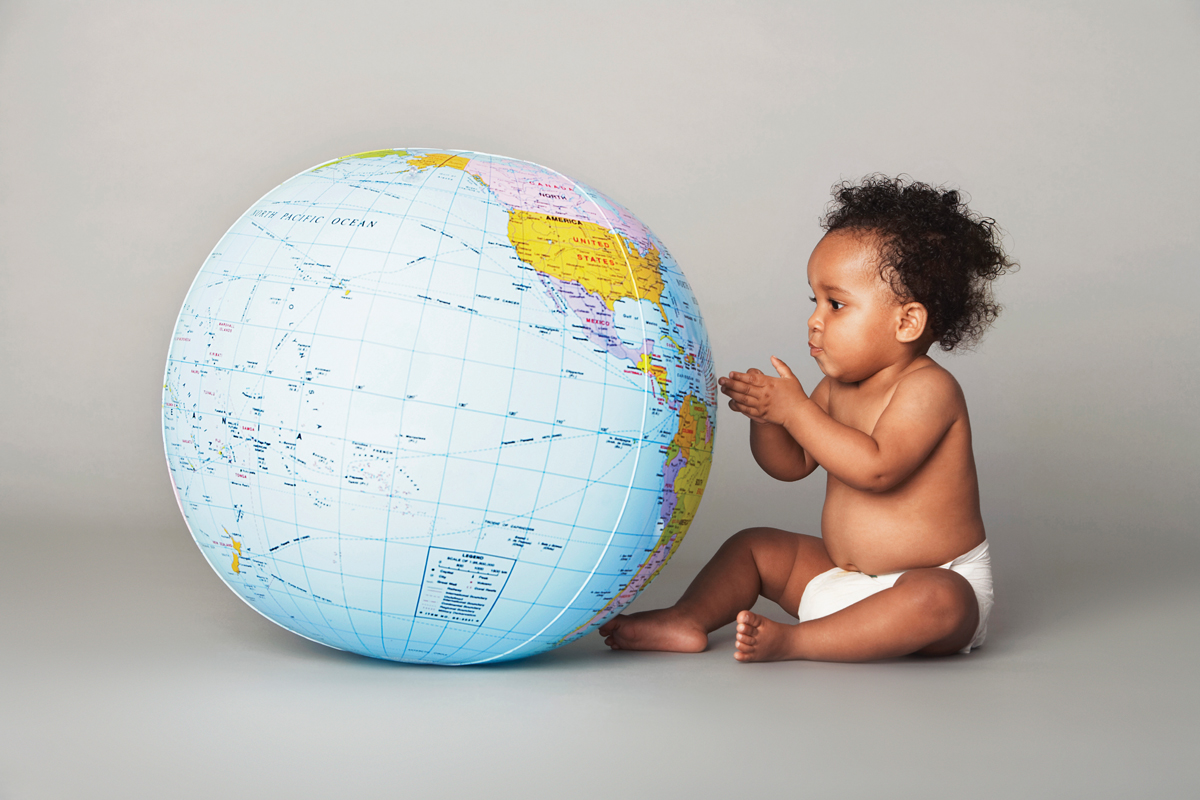This past November, Victoria Arrandale, an occupational health researcher in Toronto and former seminar student of mine, gave birth to Beatrice, whose name means “bringer of happiness.” Before Beatrice reaches her first birthday, 361,000 children will be born in Canada and almost 135 million will be born worldwide, according to the CIA World Factbook. Why does this one baby concern me? Well, because I’m a futurist, and I study the world she and all those other babies will inhabit.
“Futurist” is a hard job description to pin down. I’m the bearer of bad news and worst-case scenarios — a contemporary sentinel who, while speaking truth to power, feels obliged to speak truth to those who sometimes have no power. It’s my job to hold Beatrice and children everywhere in my thoughts as I imagine what it may take to foster human goodness and lessen human suffering in the years and decades to come.
You may unsubscribe from any of our newsletters at any time.
In Europe and India, from California’s Silicon Valley to Massey College in Toronto, I’ve researched the plausible futures of arts and culture, artificial intelligence and robotics, mental health and the socio-cultural effects of climate change. In doing so, I’ve concluded the 21st century poses greater existential risks, and therefore more peril, than any century before it. And these 21st-century risks will only grow larger and more daunting, affecting all of us, as the years pass.
I’m also a father who understands a child’s essential vulnerability. My experience as a parent of a now 26-year-old visual artist has defined my professional focus. When I imagine Canadians’ lives in a world undergoing massive changes, I feel intense compassion toward children like Beatrice and those yet unborn. This feeling has evolved into a commitment to communicate the risks we face in ways that neither paralyze listeners nor manipulate the human need to feel hope.
My memories of my son’s infancy and each stage of his development are vivid. Even though he was born in 1989, two years after global atmospheric carbon dioxide levels stopped being in the “safe zone” of 350 parts per million, he enjoyed a more stable society than today’s young children ever will.
Were I handed a newborn in 2016 and asked to soothe that baby for a few minutes before the parent returned, what would I whisper to this child, gently cradled in my arms?
Welcome to Canada, to this land, this water, this sky. May those who raise you love you and keep you safe as best they can. May your teachers and friends be kind and wise, and help you be brave. As you grow, may clear words and careful listening help you face a more challenging world.
My work as a futurist involves developing an evidence-based understanding of longer-term prospects for our country and our world. A number of stressors are shaping our young century. The most significant of these is climate change and the resulting weather extremes that will profoundly affect our minds, our bodies and our country’s and planet’s functioning. To some degree, the other stressors are touched by climate change: economic reordering that will lead to lower earnings and precarious employment; and mental health burdens affecting collective decision-making, health and well-being.
Circumstance defines us more than we imagine; as a result of climate change, already difficult conditions will become even more uncertain in the decades ahead. Many of the proposed steps for staving off the climate crisis — from cap-and-trade systems to zero-carbon-footprint regimes — will only delay some effects of catastrophic climate change for about a quarter century. The grim truth is that psychological and behavioural limits to human adaptation mean there’s little we can do now to prevent climate-related disasters, although there’s much we can do to reduce them. In Beatrice’s lifetime, our job will be to develop ways to adapt to these much-altered societal and planetary conditions. As parents, we are challenged to raise our children to be strong and purposeful even as our own ability to control external circumstances declines, and the impulse to give in to despair grows.
Some policy-makers are well aware of the potential for widespread collective anguish. Six years ago, I attended a conference in the Swedish countryside. There, I met an analyst who worked at Sweden’s equivalent of Public Safety Canada, the federal department that administers everything from emergency preparedness to the secret services. I was invited to a small-group discussion on climate adaptation back in Stockholm. There were four people in the room besides me: my analyst contact, two of his colleagues and the policy director, who reported to the agency’s top official.
I kicked off the dialogue by mentioning I’d enlisted Robert Correll, chair of the Arctic Climate Impact Assessment, as an adviser. I told the group about an earlier conversation with Correll in which he completely agreed that we are in an “extreme adaptation scenario” — a scenario requiring a massive, collective and costly response — versus an adaptation or mitigation scenario.
After I elaborated on the significance of this, one participant said, “The official policy of our government is to mitigate climate change. Some of the plausible adaptation scenarios are so disturbing they would paralyze us.”
I, too, had wondered if the future was too overwhelming to contemplate after so little action resulted from the Copenhagen climate conference the year before. But to hear an expert say it in that closed-door session reminded me of the grave state of our collective human condition. When plausible realities become unspeakable, how is it possible to marshal the necessary resources to prepare for them?
Since that 2010 meeting, global risks have grown measurably. With the explosion in digital media, the challenge of communicating those risks has grown too. Audiences are fragmented by the sheer number of media available to them; reaching into their hearts and minds with effective and factual insight is harder than ever. As existential risks grow, so too does the desire to minimize social discomfort. Recent polling by the Yale Project on Climate Change Communication reports that U.S. survey respondents are hesitant to converse about climate change with friends and family: 74 percent of Americans said they “rarely” or “never” discuss global warming, a 14 percent increase from 2008. Social pushback like this inhibits free expression — not just of facts, but of anxieties as well.
Discomfort with evidence does not absolve us of the obligation to face up to it and communicate credibly with our children and communities. This largely means contemplating the reality that the 21st century is not the postwar 20th century. The differences between the eras couldn’t be starker.
The postwar 20th century enjoyed relative climatic stability and safe levels of atmospheric carbon dioxide. Already, the 21st century has moved well beyond historical precedent. The concentration of CO2 in the atmosphere now hovers at 400 parts per million, a level climatologists say has not been seen on Earth for three million or more years. We are, in essence, an advanced civilization of increasing complexity inhabiting a prehistoric atmosphere. The implication of this is that no child born in 2016 will experience a “normal” climate; a child born today will simply experience, as we transition to the new and more chaotic climate regime, glimpses of what the climate used to feel like when seasons and other natural cycles were more predictable.
Recent research by the U.S. National Academy of Sciences suggests that global warming will impact societies via abrupt rather than gradual changes, in the form of extreme weather and other natural disasters. Until we’re forced to respond to these shocks, we won’t see whether we’re able to bounce back from them. Once there’s a pattern of being unable to return to prior normalcy, we’ll find ourselves without road maps in dauntingly unfamiliar territory.
Economically, the 21st century will be no less cushioned from volatility. If the postwar 20th century was an era of opportunity with underlying risks, the 21st century is an era of risk with underlying opportunities.
An analogy: the 20th century enjoyed a regular Snakes and Ladders game board, with a roughly equal proportion of snakes to ladders, whereas a 21st-century game board would have many more snakes and fewer ladders. And because economic and environmental conditions are moving outside historical memory, our ability to know how and where to invest will be sorely tested. With no precedent for the sheer magnitude of risk we’re facing, investors, whether they’re individuals or groups like pension funds, will have few Plan Bs to rely on.
The final casualty of this confluence of climate chaos and economic turmoil may be mental health — our collective cognitive ability to make sound decisions under stress. This raises alarm bells because mental and emotional stability, combined with technology, are among our most essential support tools for adapting to profound change.
I recall a conversation with Dr. James Orbinski, professor of global health at the University of Toronto. “So, the big question, Sanjay,” he asked, “is when do the changes you’re concerned about happen?”
That’s the $1.9-trillion question, which is the estimated mean global cost of the impact of climate change — on water, health, infrastructure, coastal zones and ecosystems — by the year 2060 if no adaptation takes place, according to the International Institute for Environment and Development and the Grantham Institute for Climate Change, both based in London, England.
One hint about timing came in a much-cited 2013 paper that modelled the date of climate departure — that is, the approximate date when the coldest year in any given location would be warmer than the hottest year for that location in the 1860 to 2005 temperature record. University of Hawaii climate researcher Camilo Mora worked with colleagues and supercomputers to calculate the mean year when cities around the world would experience this climatic tipping point under “business as usual” carbon emission conditions.
Mora and his team calculated that three of Canada’s biggest cities — Toronto, Montreal and Vancouver — would reach their climate departure during a 10-year span starting in 2046. For mid-latitude cities, the tipping point is much sooner. Mumbai, India, would reach it in 2034, Havana in 2031, Accra, Ghana, in 2027, and Port-au-Prince, Haiti, in less than a decade from now, 2025. The global average is 2047.
“The results shocked us,” Mora said in a press release. “Regardless of the scenario, changes will be coming soon. Within my generation, whatever climate we were used to will be a thing of the past.”
Aggressively cutting emissions, according to the research, would delay the worldwide timing by 22 years, but the closer a city is to climate departure, the less of a break they’d receive if carbon emissions were quickly ramped down. According to the Intergovernmental Panel on Climate Change, business and government decision-making processes, combined with a severely limited capacity among organizations and communities to scale responses to the risks, likely mean carbon emissions globally will not be reduced enough to significantly push back the climate departure years.
So it’s plausible that by around 2050, Canada will have tipped entirely into a more threatening climate regime. What might the years leading up to 2050 look like?
• 2016 to 2022 — These will be the most stable years. Canadian citizens, business leaders and public policy-makers will need to come together to build the social capital necessary for confronting the challenges of the coming decades.
• 2023 to 2030 — Food prices spike unpredictably as fruit, vegetables, grains and other commodities are affected by extreme weather in mid-latitude countries such as Cuba, Ghana and Haiti. Mental health burdens increase for the century’s remainder.
• Circa 2031 — Global financial markets reel as environmental shocks in China and India affect supply chains.
• Circa 2050 — Climate departure in Canadian cities contributes further economic and environmental stressors. Canada’s middle class continues to shrink.
I realize what you’re reading is awfully bleak, and I’m sorry if you find it upsetting. Offering uncomfortable truths is an occupational hazard for a certain breed of futurist. We’re remiss if we don’t share what we know, since people need time to prepare their heads and hearts for what may come. I have an obligation, for example, to warn Beatrice’s parents that much of what was normal for them as children in the 20th century will not be normal for their daughter in the 21st. The coming uncertainties and shocks will disrupt the traditional course of childhood psychosocial development; parents will need to understand those changes to prepare strategies for supporting their children’s healthy growth.
But futurists don’t just sound alarms. We have another responsibility: to identify plausible hope and opportunities amid risk, even risk as unprecedented as what’s ahead.
Generally speaking, I doubt that hope and opportunity will arise from social protest; traditional rabble-rousing is unlikely to prompt a response from business and government that’s commensurate with the scale of the coming changes. Rather, I anticipate our best source of hope for adapting to the future will be in the quiet and determined resolve of communities to organize around exigencies we’re likely to face — independently of, and together with, business, government and not-for-profits.
Developing local buffers against shocks using available resources, skills and scientific and traditional knowledge is what academics call “social resilience.” Drawing on a societal-adaptation framework I developed in 2014 after a decade of academic, corporate and independent research, I recommend that communities galvanize around several key areas:
• Understanding local vulnerabilities — Communities need to research and understand local vulnerabilities as they relate to physical and mental health, employment, health care and transit infrastructure. They need to identify knowledgeable individuals whose expertise on these issues can enhance community learning.
• Fostering mental well-being — Managing community mental well-being will be increasingly important. It will require training to help the vulnerable cope with an increasing sense of unease around precarious work, parenting challenges, environmental change and more.
• Creating sharing networks — Building community-based sharing networks, online and offline, will help address the increasing demand for basic goods and services. More sophisticated community networks will also be needed to co-ordinate paid, unpaid or bartered work.
• Developing humane technologies — Shared technologies such as 3D printing may be essential for adapting to future community needs. The maker movement, a convergence of computer hobbyists and traditional artisans, already provides a model for technological self-reliance and local engagement.
• Growing food — This will no longer be a hobby. Food grown in neighbourhoods will supplement store-bought produce as food prices spike. For the sake of social cohesion, those who know how to grow food will need to teach others how to do so. Local sharing networks will play an increasingly important role in maintaining some degree of equitable community food distribution and security.
• Nurturing culture — Culture is human civilization’s greatest shock absorber when times get tough. Community-based art, music and storytelling must be encouraged to help people interpret a changing world, build inner strength and find common purpose. Communities need to celebrate and support local artists in spite of challenging times.
• Guiding and learning from children — Young people are most at risk. The job of addressing their basic psychological and social development will get harder as conditions grow more difficult. And they’ll need to be taught more community-focused values — interdependence, friendship and self-reliance — to face a tougher world. In turn, their fresh insights and perspective will help to inform the way adults adapt to new realities.
Little more than two weeks after Beatrice’s birth, world leaders, corporate titans, social and environmental activists, Indigenous leaders and thousands of journalists converged in Paris for what was ostensibly the most important climate conference in history. But in my opinion, the decisions they made, or failed to make, aren’t the most important ones. Rather, the most life-enhancing decisions will be made by attentive ordinary people who choose to make Beatrice’s life — and the lives of her peers of every imaginable social, economic or cultural background — as healthy and safe as possible, no matter what happens.
For here’s the simple truth: this isn’t my world or your world or the world of attendees at the Paris climate conference. It’s Beatrice’s world now. What we do for her and her peers across Canada and in the wider world will influence what it means to be human in ways we can scarcely understand. And that’s all the more reason to learn, understand and act.
This story originally appeared in the January 2016 issue of The Observer with the title “This baby’s life.”














